Galleries
Ben Davis’s Top 5 New York Art Shows for August
Must-see shows from Sarah Charlesworth, Jaimie Warren, and more.
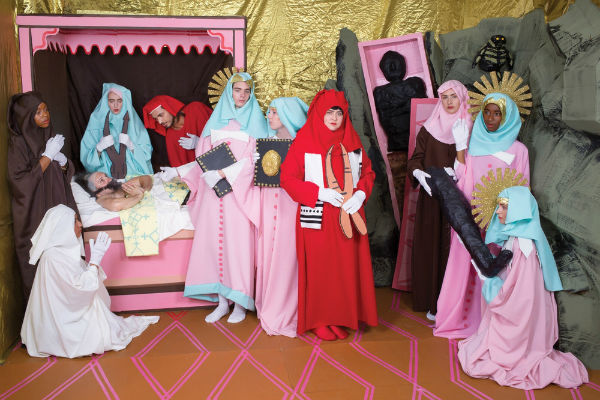
Photo: Courtesy Jamie Warren
Must-see shows from Sarah Charlesworth, Jaimie Warren, and more.

Ben Davis

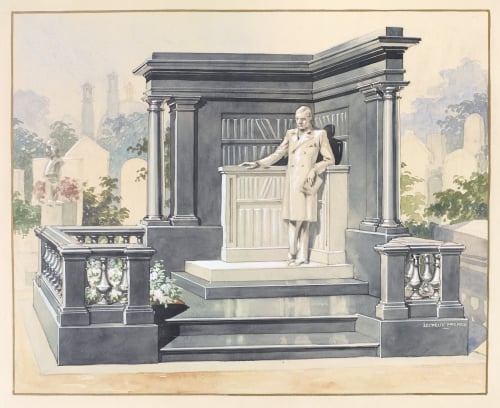
Lecreux Frères, Sketch of an unrealized tombstone of Raymond Roussel at the Père-Lachaise Cemetery (ca. 1932).
Photo: Courtesy Galerie Buchholtz.
1. “Raymond Roussel” at Galerie Buchholz, through August 29, 2015
One of the most unexpected and exciting shows of the summer, at the freshly opened uptown space, amounts to a temporary archive of works relating to the career of the eccentric French author Raymond Roussel (1877-1933). The well-to-do oddball cast a very long shadow in the art scene; his spirit felt in Georges Bataille and Michel Foucault, as well as Marcel Duchamp and John Ashbery, and even Rube Goldberg (of the eponymous machine).
As you might imagine from an art show that is about an ultra-experimental author known for wild wordplay, the show is not exactly easy to get into. There are a lot of books on view, both by Roussel and from his collection (he loved Jules Verne), as well as a number of letters, including one by Duchamp attesting to his influence. But spend enough time among all this reading material, and you will get to know the twists and turns of a creative life, and have your inspiration nourished by his quirks.
There are some visual bits too. A whole trove of antique photographic portraits by Roussel himself, found in a secret trunk of Roussel-iana in 1989, both throws light on his milieu and his obsession with babies and dogs. There is also a wonderful telling sketch detailing his design for his own grave, featuring a life-sized sculpture of a man posed among his books (above). Studded throughout are artworks by celebrated artists touched by his work, including Marcel Broodthaers, Joseph Cornell, and Andre Breton, and though the connections aren’t directly clear, the aura of avant-garde affection is convincing.
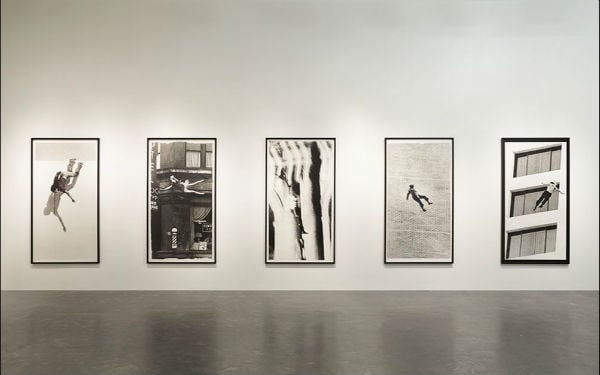
Exhibition view of “Sarah Charlesworth: Doubleworld” at the New Museum.
Photo: Courtesy New Museum.
2. “Sarah Charlesworth: Double World” at New Museum, through September 20, 2015
Charlesworth, who died in 2013, is one of the central, if less celebrated, figures of the “Pictures Generation,” a severe and brainy artist.
Like a lot of “Pictures” work (which was also once taught to me as “phototheory art”), a lot of the material in the New Museum’s fine but less-than-complete show seems to me to be both prophetic and superseded: provocative notions like set-up photography and appropriation are now the lingua franca of the internet. Hearing people ooh and ah over them today is a bit like watching that clip of Bryant Gumbel on an old Good Morning America broadcast, trying to explain to the audience how to use that “little mark with the ‘a’ and the ring around it.”
But at least one Charlesworth series here, her most well-known, “Stills” from 1980, still stops you in your tracks: a series of grainy photographs of people captured falling from buildings, ripped from their newspaper context and blown up to wall-filling side. The “Stills” are chilling if somewhat familiar, making you think of Warhol’s “Death and Disasters” series as well as more recent images World Trade Center jumpers during 9/11—the violence of their neutralizing decontextualization both negating and mirroring the violence depicted.
Mainly, though, it’s the scale of the “Stills” that strikes you, the way the images’ magnification makes them both more powerful and less exact as the images lose resolution, becoming cold, towering monoliths of tragedy.
When the Museum of Modern Art was first collecting “Pictures Generation” work, it had to be done by the sculpture department rather than the photography department, which thought it beneath their standards. Now, that’s looked at as having been an embarrassing blind spot, based on a dated attachment to a certain type of formalist art photography. But looking at Charlesworth’s imposing stills today, I think there may have been some wisdom in it as well, in the way the power of the best work comes from how it uses the images’ physicality.
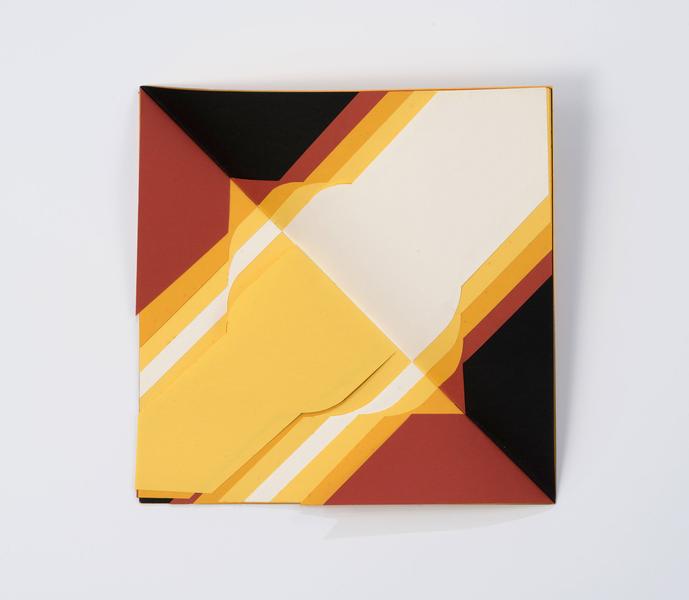
Raymundo Colares, Gibi (1970).
Photo: Courtesy Luhring Augustine.
3. “Empty House / Casa Vacia” at Luhring Augustine, through August 28, 2015
Curators Lucrecia Zappi and Donald Johnson Montenegro check in on the legacy of Brazilian Neoconcretism, the path of freestyle geometric abstraction took in Brazil at the dawn of the 1960s. It gathers some dollops of classic work by the now-towering figures of the era, like Lygia Clark (her foldable metal origami-like “Bichos”), Helio Oiticica (an angular red-painted wood concoction, suspended from the ceiling), and Mira Schendel (a bouquet of knotted rice-paper knots from her “Little Nothings” series). Then it mixes these liberally with more recent works that have a similar, jocular but abstract vibe, like Rodrigo Matheus’s Em Obras, a 2014 installation featuring a piece of fence planted in a pile of sand, draped with diaphanous blue fabric.
Overall, the show is a tad over-decorous for my taste, with the most novel aspects of Neoconcretism—its vibrant turn towards interactivity in artists like Clark and Oiticica—not really highlighted, so that it comes off as a kind of funky variation on post-minimalism (the only real work you can engage with is contemporary artist Adriano Costa’s Norwegian Cheese (2014), a perforated metal floor piece, which is great if you’ve ever wondered what it might be like to walk across a floor of metallic cheese).
Still, as a guide pointing you at one path through recent Brazilian art, “Casa Vacia” is well worth following.
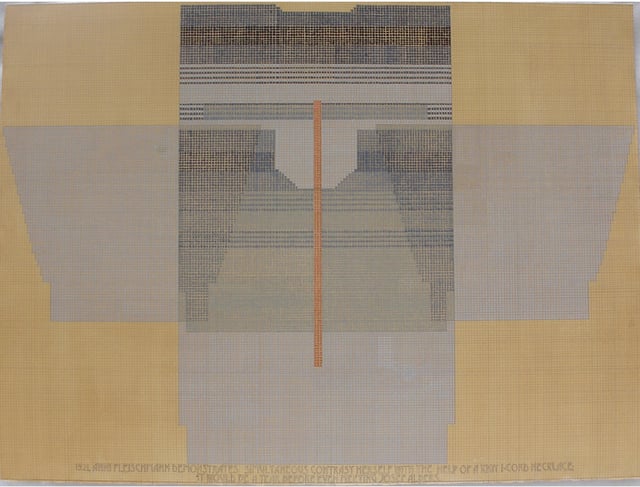
Ellen Lesperance, 1921, Annie Fleischmann Demonstrates Simultaneous Contrast Herself with the Help of a Knitted I-Cord Necklace: It Would Be a Year Before Even Meeting Josef Albers (2009).
Photo: Courtesy Mixed Greens.
4. “Common Thread” at Mixed Greens, through August 28, 2015
The first-floor space is closing after 16 years in operation, but check out this show first, featuring a variety of female artists whose work muddles the distinction between painting and textiles. For all the hoopla around abstract painting, after all, textiles were doing abstract pattern way before the big boys of modern art were playing around with pure colors, while the all-important modernist grid was already the literal warp and woof of loomcraft.
The centerpiece and highpoint of the show is by Ellen Lesperance: 1921, Annie Fleischmann Demonstrates Simultaneous Contrast Herself with the Help of a Knitted I-Cord Necklace: It Would Be a Year Before Even Meeting Josef Albers (2009), a gouache recreating a pattern by the important Bauhaus textiles teacher Anni Albers (long in the shadow of her husband, abstract art guru Josef), with the titular phrase inscribed beneath. The piece is both cheeky and thoughtful, an artwork that serves in its own way as a manifesto.

Jaimie Warren, Still from Somebody To Love (2015).
Photo: Courtesy Jaimie Warren.
5. “Jaimie Warren: Somebody to Love” at American Medium, through September 13, 2015
The Bed-Stuy gallery has a live one with the inimitable Jaimie Warren, known and loved for frenzied art carnivals that mash together pop art and community-based art, a kind of big-hearted surrealism that is challenging but also genuinely fun. Here she tapped the brains of a trio of local high school students to conceive something that is advertised as both an elaborate art-gallery tribute to both medieval art (Matteo di Pacino’s St. Cosmas and St. Damian, ca. 1370-1375) and classic rock (specifically, Queen).
What you will find, should that mash-up entice you, is a strange stage-set like installation, and a delirious music video involving, from what I can tell, a nun’s love affair with an amputated leg, set to the Queen anthem Somebody to Love. The opening, which featured Warren performing as Freddie Mercury (for a start), was a gas.